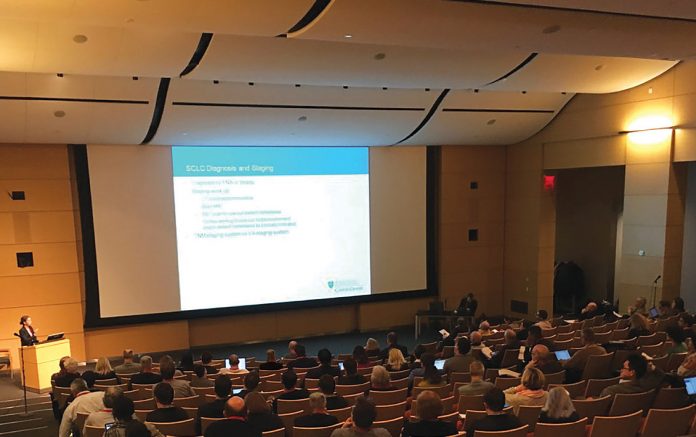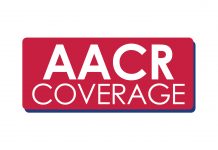Posted: April 2017
By Kristina Wasson-Blader, PhD, ELS
International Association for the Study of Lung Cancer (IASLC) hosted the second Small Cell Lung Cancer Workshop at Memorial Sloan Kettering Cancer Center in New York, New York, which is held on an every-other-year basis. This focused meeting attracted more than 175 leading basic scientists and clinical investigators from around the world whose mission includes the treatment and eradication of small cell lung cancer (SCLC). The most recent advances in SCLC research and clinical trials were discussed, including genomic studies on human tumors, the generation and analysis of novel models to study SCLC, the identification of biomarkers of cancer initiation and response to treatment, and the development of novel targeted therapies, including immunotherapies. Co-chair of the meeting, Julien Sage, PhD (Stanford University) indicated that “the main message was that the field is moving from a fairly ‘homogeneous’ view of SCLC to a recognition of genetic, histologic, and cellular heterogeneity.” The other three co-chairs of the Workshop included Lauren Byers, MD (MD Anderson Cancer Center), Anna Farago, MD, PhD (Massachusetts General Hospital Cancer Center), and J.T. Poirier, PhD (Memorial Sloan-Kettering Cancer Center).
During this 3-day meeting, attendees listened to presentations grouped by topic into 9 separate sessions. Peter Ujhazy, MD, PhD (Translational Research Program, National Cancer Institute [NCI]) gave the opening talk on behalf of the NCI and discussed current NIH funding opportunities through the SCLC Consortium’s U01 mechanisms. He also noted that Dr. Charles Rudin of MSKCC and others were recently awarded a U24 grant that will support their role as the Coordinating Center. SCLC pathology was also discussed on the first day. Dr. Julien Sage described a talk by Ignacio Wistuba, MD, (MD Anderson Cancer Center) as “one of the most thoughtprovoking because it raised the question of how small cell lung cancer initiates in the lungs of a patient. Small precursor lesions for SCLC are basically never seen in patients, and mouse models do not exactly recapitulate the lung microenvironment because SCLC patients are nearly always heavy smokers. Discussion of the possible existence of a cancer field effect for SCLC was of high interest.”
On the second day of the meeting, six discrete sessions covered the topics of genomics and genetic models, developmental genetics and epigenetics, tumor heterogeneity, platforms for discovery, and targeted therapies. Paul Bunn, Jr, MD (University of Colorado) chaired the discussion of targeted therapies and summarized this session: “New targets in DNA repair pathways, cell cycle checkpoints, and stem cells all have the potential to be biomarkers for SCLC and may be useful in choosing therapy based on these targets as we get closer to providing patients with more personalized medicine. It is important to note that these targets are quite different than those found in lung adenocarcinomas.”
The last day of the meeting included sessions on biomarkers, immunotherapy, and recent or ongoing clinical trials in SCLC. There were a number of new novel therapies covered (e.g., Rovapituzumabtesirine [ROVA-T], PARP inhibitors, lubrenectidin, nano-lipo-irinotecan [nal-IRI] and others), for which there was considerable enthusiasm, based on the presentations. Suresh Ramalingam, MD, (Emory University School of Medicine) presented his work on PARP inhibitors. He noted that “Our work with PARP inhibitors has provided an important avenue to improve the efficacy of current treatment approaches.”
In addition to targeted therapies, the meeting focused on new developments in immunotherapy for SCLC, including the recent addition of immunotherapy agents to the NCCN treatment guidelines for SCLC. “The activity of several immunotherapy agents in a subset of SCLC patients opens a new avenue for translational research in this field. Investigations into mechanisms of immune escape in SCLC, disease-specific biomarkers, and approaches to enhance clinical responses to immunotherapy represent important areas of opportunity,” said Lauren Byers, Co-chair.
Reflecting on the meeting in general and the status of current research, Dr. Ramalingam added, “This is the second meeting fully dedicated to discussing research focused on SCLC. The topics spanned basic research to exciting novel approaches in the treatment of SCLC. The meeting left me with the hope that breakthroughs in the treatment of this lethal disease are imminent.”✦










